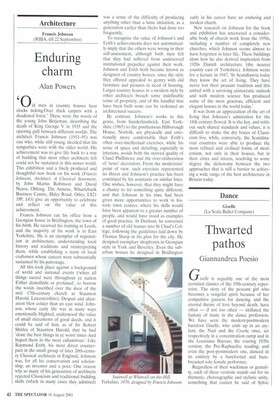Enduring charm
Alan Powers
0 Id men in country houses hear clocks ticking/Over thick carpets with a deadened force.' These were the words of the young John Betjeman, describing the death of King George V in 1935 and the opening gulf between different worlds. The architect Francis Johnson (1911-95) was one who, while still young, decided that his sympathies were with the older world. His achievement was to give life back to a way of building that most other architects felt could not be sustained in this newer world. This exhibition and a finely produced and thoughtful new book on his work (Francis Johnson, Architect: A Classical Statement, by John Martin Robinson and David Neave, Oblong, The Annexe, Wharfebank Business Centre, Ilkley Road, Otley, LS21 3JP, £43) give an opportunity to celebrate and reflect on the value of this achievement.
Francis Johnson ran his office from a Georgian house in Bridlington, the town of his birth. He received his training at Leeds, and the majority of his work is in East Yorkshire. He is an exemplar of regionalism in architecture, understanding local history and traditions and reinterpreting them, while establishing a team of local craftsmen whose careers were substantially sustained by his patronage.
All this took place against a background of world and national events ('when all things sacred were throughout ye nation Either demollisht or profaned', to borrow the words inscribed over the door of the mid 17th-century church at Staunton Harold, Leicestershire). Despair and alienation blew colder than an east wind. Johnson, whose early life was in many ways emotionally blighted, understood the value of small increments of good deeds, and it could be said of him, as of Sir Robert Shirley of Staunton Harold, that he had 'done the best things in ye worst times And hoped them in the most callamitous'. Like Raymond Erith, his most direct counterpart in the small group of later 20th-century Classical architects in England, Johnson was, for all his conservatism and scholarship, an inventor and a poet. One reason why so many of his generation of architects rejected Classicism and traditional building skills (which in many cases they admired) was a sense of the difficulty of producing anything other than a lame imitation, as a generation earlier than theirs had done too frequently.
To recognise the value of Johnson's and Erith's achievements does not automatically imply that the others were wrong in their self-assessment, although both men felt that they had suffered from undeserved institutional prejudice against their work. Johnson and Erith both became known as designers of country houses, since the style they offered appealed to gentry with old furniture and pictures in need of housing. Larger country houses in a modern style by other architects breach some indefinable sense of propriety, and of the handful that have been built none can be reckoned an architectural success.
By contrast. Johnson's works in this genre, from Sunderlandwick, East Yorkshire (1965) to the posthumous Hi!borough House, Norfolk. are physically and emotionally more comfortable than Erith's often over-intellectual exercises, while his sense of space and detailing, especially in interiors, avoids both the starved quality of Claud Phillimore and the over-elaboration of 'retro' decorators. From the modernists' point of view, such exercises represented no threat and Johnson's practice has been continued by his assistants on similar lines. One wishes, however, that they might have a chance to try something quite different, and that Johnson in his time had been given more opportunities to work in historic town centres, where his skills would have been apparent to a greater number of people, and would have stood as examples of good practice. In Durham, he converted a number of old houses into St Chad's College, following the guidelines laid down by Thomas Sharp in his plan for the city. He designed exemplary shopfronts in Georgian style in York and Beverley. Even the suburban houses he designed in Bridlington early in his career have an enduring and modest charm.
New research on Johnson for the book and exhibition has uncovered a considerable body of church work from the 1950s, including a number of completely new churches, which Johnson seems almost to have forgotten in later life. These buildings show how he also derived inspiration from 1920s Danish architecture (the nearest country east of Yorkshire). Johnson wrote for a lecture in 1947, 'In Scandinavia today they know the art of living. They have never lost their peasant tradition and this united with a surviving aristocratic outlook and with modern science has produced some of the most gracious, efficient and elegant houses in the world today.'
It was from an appreciation of the art of living that Johnson's admiration for the 18th century flowed. It is the key, and without such shared standards and values, it is difficult to make the dry bones of Classicism live, while, conversely, the Scandinavian countries were able to produce the most refined and civilised forms of modernism, not only in their houses, but in their cities and streets, resolving to some degree the dichotomy between the two approaches that is still a barrier to achieving a wide range of the best architecture in Britain today.


























































 Previous page
Previous page